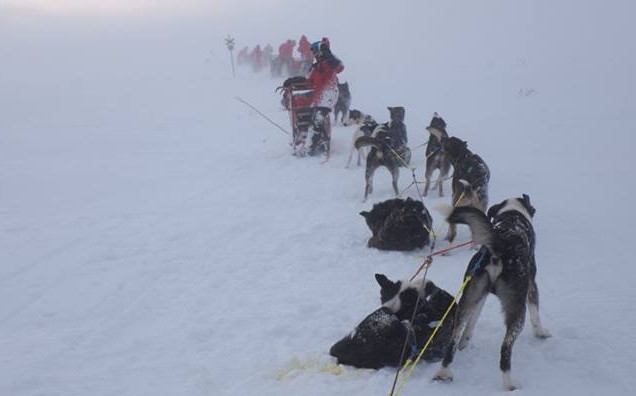Last June I wrote about eight enterprising girls calling themselves Atte HUSKYteers, who set themselves a challenge to complete a six-day, 285km dog sled adventure through the Arctic wilderness, across the roof of the world.
They successfully completed their expedition in March and as I wanted to learn something about husky dogs’ characteristics and temperament, and about the whole experience of mushing, I had a long conversation with trip organiser Amanda Nissen.
Mushing is “fantastic”, said Amanda, “You connect with your dogs”. Her enthusiasm for them was infectious.
The Huskyteers became attached to their dogs, protective about their teams and gained a huge respect for their capabilities.
Huskies have deep and velvety fur, especially round the ears, which have as much hair on the inside as outside to protect them from temperatures which can fall as low as -30°C.
Each girl’s sled had a team of five dogs on a 2:1:2 line-up and they were responsible for their team’s wellbeing.
They weren’t there for a holiday and helped with feeding and cleaning up the environment each morning – 55 dogs can leave a large calling card.
They harnessed up their teams each morning and at the end of the day, prepared their bedding area and checked their dogs for injuries or other health issues.
Musher’s muddle
Most important was ensuring that their dogs didn’t get entangled with the other dogs, which could create something of a musher’s muddle and be difficult to disentangle.
The dogs run and run – powerhouses of boundless energy and never so happy as when they are working.
They can keep up a steady 5km per hour, pulling on average 140kgs. On the last day, due to earlier bad weather, the dogs ran for 100km with only three short stops.
It was a very physical experience for the girls and their year-long training preparing for the journey proved absolutely essential for its success.
If a musher fell off her sled and didn’t hang on to it, her dogs carried on regardless until one of the guides could reunite them.
The moment the musher had control again her dogs took off full pelt – they just wanted to work.
The dogs were nonetheless wonderfully disciplined, working with each other and responding to their musher’s instructions.
They have exceptional navigation skills and will follow a trail in the worst conditions.
Unerring trail
Amanda fell off her sled in a whiteout blizzard. By the time she had gained control of her dogs the other teams were far ahead. Her dogs picked up the trail unerringly to rejoin the others.
At night, camping out in the Arctic wilderness, the girls pitched their tents and the dogs dug themselves a shallow snow hole, curled up and fell asleep. In the mornings the girls found them covered in snow with their tails wrapped round to cover the tips of their noses.
They proved wonderful watchdogs. Several times each night something disturbed them and 55 huskies raised their voices and “sang” to the moon, warning off the perceived danger. Despite being woken, the girls found it calming and reassuring.
Huskies are biddable, affectionate, intelligent, beautiful workaholics who just want to please their mushers. They are not household pets and in the extreme conditions of the Arctic Circle a bond of interdependence and trust quickly develops between dogs and handlers.
The story moves to the other end of the world now.
A month ago I wrote about my tenuous connection with the Antarctic through Cape Whitson on Laurie Island in the South Orkney Islands, named after my great-uncle. A reader got in touch to tell me that he had visited Laurie Island in 2004 and sent a photograph of what might have been the ancestral cape – and a lonely and windswept spot it looks.
Then the Doyenne bought me a book – Of Dogs and Men: 50 Years in the Antarctic – The Illustrated Story of the Dogs of the British Antarctic Survey, 1944-1994. It’s beautifully produced, with photographs on almost every page of huskies and the Antarctic landscape, plus extracts from survey members’ diaries.
When Second World War was seen to be turning in the Allies’ favour, Britain was keen to stake a claim in Antarctica and the British Antarctic Survey (BAS) was established in 1944.
The desolate and inhospitable South Pole has no permanent, indigenous inhabitants and few indigenous species other than penguins, seals and whales.
Dogs were recognised as the best form of transport and a pack of huskies was brought down from the Arctic which would be the basis of the colony of dogs which served the survey until an environmental protocol of 1994 banned all non-native species from Antarctica except man.
What shines out from the BAS members’ diaries is the same sense of partnership between the dogs and their handlers as the Huskyteers experienced – the same characteristics of patience and endurance and love of work for its own sake, the bonds of loyalty and interdependence.
It’s clear to me that mushers achieve a working harmony with their huskies that you’ll find with few other working breeds.


